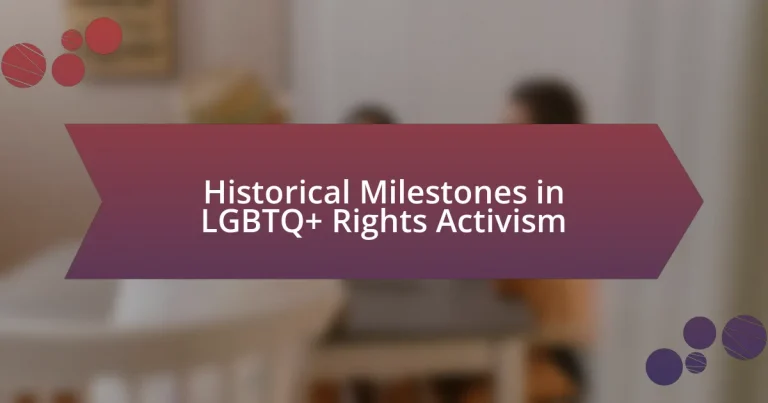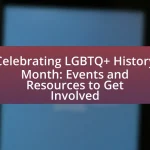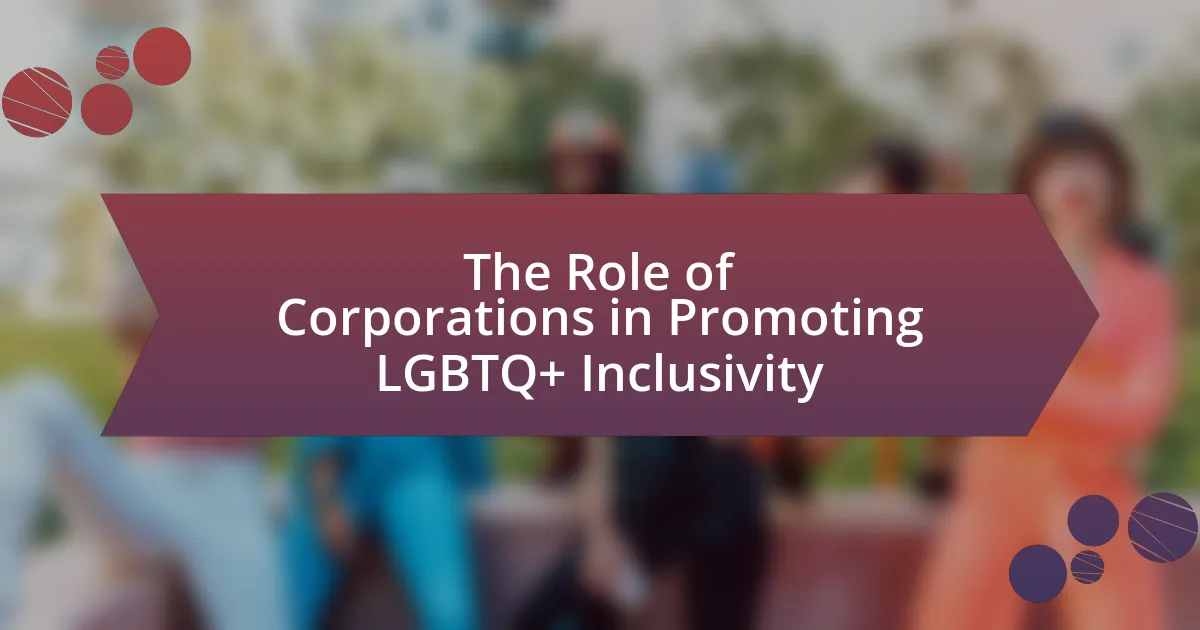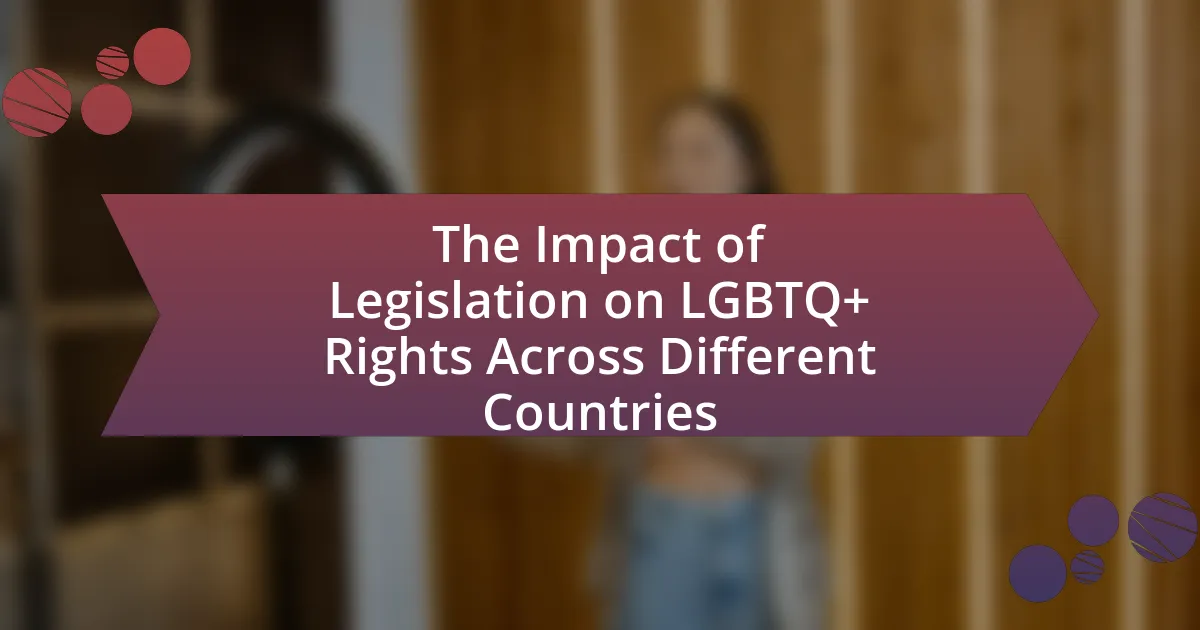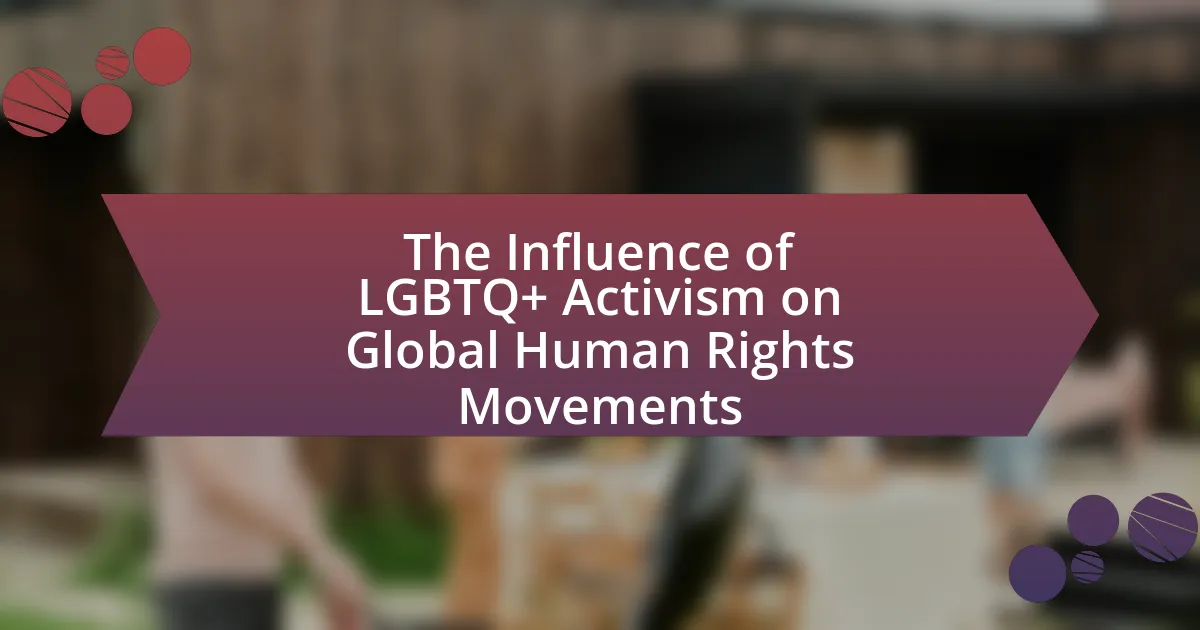The article focuses on the historical milestones in LGBTQ+ rights activism, highlighting key events such as the Stonewall Riots of 1969, which catalyzed the modern movement for equality in the United States. It discusses the formation of early organizations like the Mattachine Society and the Daughters of Bilitis, the impact of the AIDS crisis on activism, and significant legislative achievements, including the legalization of same-sex marriage. Additionally, the article examines ongoing challenges faced by the LGBTQ+ community, such as discrimination and social stigma, while emphasizing the importance of continued advocacy and allyship in the fight for equal rights.

What are the key historical milestones in LGBTQ+ rights activism?
Key historical milestones in LGBTQ+ rights activism include the Stonewall Riots of 1969, which marked a significant turning point in the fight for LGBTQ+ rights in the United States. The riots were a response to a police raid at the Stonewall Inn in New York City, leading to increased visibility and activism within the LGBTQ+ community. Following this, the first Pride marches took place in 1970, commemorating the riots and advocating for equal rights. In 1973, the American Psychiatric Association removed homosexuality from its list of mental disorders, a crucial step in combating stigma. The 1996 Defense of Marriage Act, which defined marriage as between one man and one woman, was later challenged, leading to the landmark Supreme Court decision in 2015 that legalized same-sex marriage nationwide. These milestones collectively represent significant progress in the ongoing struggle for LGBTQ+ rights and recognition.
How did early movements shape the foundation of LGBTQ+ rights?
Early movements laid the groundwork for LGBTQ+ rights by advocating for visibility, decriminalization, and social acceptance. The Mattachine Society, founded in 1950, was one of the first organizations to promote gay rights in the United States, challenging societal norms and pushing for legal reforms. Similarly, the Daughters of Bilitis, established in 1955, focused on lesbian rights and created a supportive community, which was crucial for raising awareness and fostering activism. These organizations organized events, published literature, and engaged in public demonstrations, such as the 1965 Independence Day protests, which marked one of the first public demonstrations for gay rights. Their efforts contributed to the eventual Stonewall Riots in 1969, a pivotal moment that galvanized the LGBTQ+ movement and led to the formation of more activist groups. The cumulative impact of these early movements established a foundation for subsequent legal advancements, including the decriminalization of homosexuality and the recognition of same-sex marriage.
What were the significant events in the early LGBTQ+ rights movement?
The significant events in the early LGBTQ+ rights movement include the Stonewall Riots of 1969, which marked a pivotal moment in the fight for LGBTQ+ rights in the United States. The riots were a response to a police raid at the Stonewall Inn in New York City, leading to several days of protests and increased visibility for LGBTQ+ issues. Following Stonewall, the first Pride marches took place in 1970, commemorating the riots and advocating for LGBTQ+ rights. Additionally, the formation of organizations such as the Gay Liberation Front in 1969 and the Human Rights Campaign in 1980 played crucial roles in mobilizing activism and raising awareness. These events collectively laid the groundwork for subsequent advancements in LGBTQ+ rights and visibility.
Who were the pivotal figures in the early stages of activism?
The pivotal figures in the early stages of LGBTQ+ rights activism include Marsha P. Johnson, Sylvia Rivera, and Harvey Milk. Marsha P. Johnson, a Black transgender activist, co-founded the Street Transvestite Action Revolutionaries (STAR) in 1970, advocating for the rights of transgender individuals and homeless LGBTQ+ youth. Sylvia Rivera, a Venezuelan-American activist, worked alongside Johnson and was instrumental in the Stonewall uprising of 1969, which marked a significant turning point in the fight for LGBTQ+ rights. Harvey Milk, the first openly gay elected official in California, served on the San Francisco Board of Supervisors and was a prominent advocate for LGBTQ+ rights until his assassination in 1978. Their contributions laid the groundwork for the modern LGBTQ+ rights movement, influencing legislation and public perception.
What role did the Stonewall Riots play in LGBTQ+ activism?
The Stonewall Riots served as a catalyst for the modern LGBTQ+ rights movement, igniting widespread activism and advocacy. Occurring in June 1969 at the Stonewall Inn in New York City, these riots were a response to police raids and systemic discrimination against LGBTQ+ individuals. The events galvanized the community, leading to the formation of organizations such as the Gay Liberation Front and the first Pride marches in 1970, which aimed to promote visibility and equality. The riots are widely recognized as a pivotal moment that shifted LGBTQ+ activism from a largely underground movement to a more public and organized effort for civil rights, influencing subsequent legislation and societal attitudes towards LGBTQ+ individuals.
How did the Stonewall Riots influence public perception of LGBTQ+ rights?
The Stonewall Riots significantly shifted public perception of LGBTQ+ rights by catalyzing a national movement for equality and visibility. Occurring in June 1969, the riots marked a turning point in LGBTQ+ activism, leading to increased awareness and support for LGBTQ+ issues among the general public. Following the events, organizations such as the Gay Liberation Front emerged, advocating for rights and acceptance, which contributed to a gradual change in societal attitudes. Polls conducted in subsequent years indicated a rise in public support for LGBTQ+ rights, reflecting the impact of the riots on mainstream consciousness. The Stonewall Riots are often credited with igniting Pride celebrations and fostering a sense of community and solidarity within the LGBTQ+ population, further influencing public perception positively.
What were the immediate outcomes of the Stonewall Riots?
The immediate outcomes of the Stonewall Riots included heightened visibility for LGBTQ+ issues and the galvanization of the gay rights movement. Following the riots in June 1969, LGBTQ+ individuals began organizing more actively, leading to the formation of advocacy groups such as the Gay Liberation Front. The riots also sparked annual pride celebrations, with the first Pride March occurring in June 1970 to commemorate the events at Stonewall. These developments marked a significant shift in public awareness and activism surrounding LGBTQ+ rights, contributing to the broader fight for equality and social acceptance.
How did the AIDS crisis impact LGBTQ+ rights activism?
The AIDS crisis significantly accelerated LGBTQ+ rights activism by highlighting systemic discrimination and the urgent need for healthcare and social justice. Activists mobilized in response to the crisis, forming organizations like ACT UP (AIDS Coalition to Unleash Power) in 1987, which demanded government action and increased funding for AIDS research and treatment. This activism not only raised awareness about the epidemic but also brought attention to broader issues of LGBTQ+ rights, including the fight against homophobia and the demand for equal treatment under the law. The crisis galvanized a generation of activists, leading to landmark changes such as the eventual legalization of same-sex marriage and the establishment of anti-discrimination laws, demonstrating the profound impact of the AIDS crisis on the LGBTQ+ rights movement.
What organizations emerged in response to the AIDS crisis?
Several organizations emerged in response to the AIDS crisis, including ACT UP (AIDS Coalition to Unleash Power), founded in 1987, which focused on direct action to advocate for AIDS research and treatment. Another significant organization is the Gay Men’s Health Crisis (GMHC), established in 1982, which provided support services and education for those affected by HIV/AIDS. The Human Rights Campaign (HRC), while founded earlier in 1980, intensified its focus on AIDS advocacy during the crisis. These organizations played crucial roles in raising awareness, providing support, and pushing for policy changes related to HIV/AIDS.
How did activism during the AIDS crisis change the landscape of LGBTQ+ rights?
Activism during the AIDS crisis significantly advanced LGBTQ+ rights by mobilizing communities, raising awareness, and demanding government action. Organizations like ACT UP (AIDS Coalition to Unleash Power) utilized direct action tactics to highlight the neglect of the epidemic, leading to increased funding for research and treatment. This activism not only brought attention to the urgent health crisis but also fostered a sense of solidarity and identity within the LGBTQ+ community, ultimately contributing to broader civil rights movements. The crisis catalyzed legal and social changes, such as the eventual recognition of same-sex relationships and the push for anti-discrimination laws, marking a pivotal shift in the landscape of LGBTQ+ rights.

What legislative milestones have been achieved in LGBTQ+ rights?
Significant legislative milestones in LGBTQ+ rights include the decriminalization of homosexuality in various countries, the legalization of same-sex marriage, and the enactment of anti-discrimination laws. For instance, the U.S. Supreme Court’s decision in Obergefell v. Hodges in 2015 legalized same-sex marriage nationwide, affirming that same-sex couples have the constitutional right to marry. Additionally, the Employment Non-Discrimination Act (ENDA) has been proposed multiple times to prohibit employment discrimination based on sexual orientation and gender identity, reflecting ongoing efforts to secure workplace protections. Furthermore, many countries have enacted laws to protect LGBTQ+ individuals from discrimination in areas such as housing and public accommodations, contributing to a broader recognition of LGBTQ+ rights globally.
What are the key laws that have advanced LGBTQ+ rights?
The key laws that have advanced LGBTQ+ rights include the Obergefell v. Hodges decision, which legalized same-sex marriage in the United States in 2015, and the Employment Non-Discrimination Act (ENDA), which aimed to prohibit employment discrimination based on sexual orientation and gender identity. The Obergefell ruling was based on the constitutional right to marry, affirming that same-sex couples have the same legal rights as heterosexual couples. ENDA, although not passed as a federal law, has influenced state-level protections and has been a significant part of the conversation around workplace equality. Additionally, the repeal of “Don’t Ask, Don’t Tell” in 2011 allowed LGBTQ+ individuals to serve openly in the military, marking a significant shift in policy. These laws collectively represent critical advancements in the legal recognition and protection of LGBTQ+ rights in the United States.
How did the legalization of same-sex marriage change LGBTQ+ rights?
The legalization of same-sex marriage significantly advanced LGBTQ+ rights by providing legal recognition and equal treatment under the law. This landmark change, exemplified by the U.S. Supreme Court ruling in Obergefell v. Hodges in 2015, established that same-sex couples have the constitutional right to marry, thereby affirming their status as equal citizens. The ruling not only granted access to marriage benefits such as tax breaks, inheritance rights, and healthcare decisions but also fostered greater societal acceptance and visibility for LGBTQ+ individuals. Studies indicate that the legalization of same-sex marriage has led to increased mental health outcomes and reduced stigma within communities, highlighting its profound impact on the overall rights and well-being of LGBTQ+ individuals.
What protections have been established against discrimination based on sexual orientation?
Protections against discrimination based on sexual orientation have been established through various federal and state laws, including the Employment Non-Discrimination Act (ENDA) and the Supreme Court ruling in Obergefell v. Hodges, which legalized same-sex marriage nationwide. ENDA, although not passed as a standalone law, has influenced workplace policies and practices, leading to protections in many states and by federal agencies. The Obergefell v. Hodges decision affirmed that same-sex couples have the right to marry, thereby extending numerous legal protections and benefits associated with marriage. Additionally, the U.S. Supreme Court’s decision in Bostock v. Clayton County in 2020 ruled that Title VII of the Civil Rights Act of 1964 protects employees from discrimination based on sexual orientation, further solidifying legal protections against discrimination in employment.
How have international movements influenced LGBTQ+ rights legislation?
International movements have significantly influenced LGBTQ+ rights legislation by promoting awareness, solidarity, and legal reforms across various countries. For instance, the global visibility of events like Pride parades and campaigns led by organizations such as ILGA (International Lesbian, Gay, Bisexual, Trans and Intersex Association) have pressured governments to adopt more inclusive laws. In 2001, the Netherlands became the first country to legalize same-sex marriage, setting a precedent that inspired similar legislation in other nations, including Canada and Spain. Furthermore, the United Nations has played a crucial role by advocating for LGBTQ+ rights as human rights, leading to the establishment of various resolutions that encourage member states to protect LGBTQ+ individuals from discrimination and violence. These international movements have created a ripple effect, encouraging local activists and lawmakers to push for reforms that align with global human rights standards.
What global milestones have been achieved in LGBTQ+ rights?
Significant global milestones in LGBTQ+ rights include the decriminalization of homosexuality in various countries, the legalization of same-sex marriage, and the recognition of LGBTQ+ rights in international human rights frameworks. For instance, in 2001, the Netherlands became the first country to legalize same-sex marriage, setting a precedent that has since been followed by over 30 countries. Additionally, the United Nations Human Rights Council passed a resolution in 2011 affirming that LGBTQ+ individuals should be protected from violence and discrimination, marking a critical step in international recognition of LGBTQ+ rights. Furthermore, many countries have enacted anti-discrimination laws and policies, reflecting a growing acceptance and legal protection for LGBTQ+ individuals worldwide.
How do different countries approach LGBTQ+ rights legislation?
Different countries approach LGBTQ+ rights legislation with varying degrees of acceptance and legal recognition. For instance, countries like Canada and the Netherlands have comprehensive laws protecting LGBTQ+ rights, including same-sex marriage and anti-discrimination protections, reflecting progressive attitudes towards LGBTQ+ individuals. In contrast, nations such as Saudi Arabia and Uganda impose severe penalties for homosexuality, including imprisonment and even death, indicating a hostile legal environment for LGBTQ+ communities. According to the International Lesbian, Gay, Bisexual, Trans and Intersex Association (ILGA), as of 2021, 29 countries have legalized same-sex marriage, while over 70 countries still criminalize same-sex relations, showcasing the stark differences in legislative approaches worldwide.

What challenges remain in the fight for LGBTQ+ rights?
Significant challenges remain in the fight for LGBTQ+ rights, including discrimination, lack of legal protections, and social stigma. Discrimination persists in various sectors such as employment, housing, and healthcare, where LGBTQ+ individuals often face unequal treatment. According to a 2021 report by the Human Rights Campaign, 46% of LGBTQ+ Americans reported experiencing discrimination in their daily lives. Additionally, many countries lack comprehensive legal protections for LGBTQ+ individuals, with only 29 countries recognizing same-sex marriage as of 2023. Social stigma continues to fuel violence against LGBTQ+ individuals, with the FBI reporting a rise in hate crimes targeting this community. These ongoing issues highlight the need for continued advocacy and legal reforms to ensure equality and safety for LGBTQ+ individuals.
What ongoing issues do LGBTQ+ individuals face today?
LGBTQ+ individuals face ongoing issues such as discrimination, violence, and lack of legal protections. Discrimination manifests in various forms, including employment and housing discrimination, where studies indicate that LGBTQ+ individuals are more likely to experience job loss or eviction due to their sexual orientation or gender identity. Violence against LGBTQ+ individuals remains a significant concern, with hate crimes targeting this community reported at higher rates than those against other groups. Additionally, many regions lack comprehensive legal protections for LGBTQ+ rights, leading to disparities in healthcare access and social services. According to the Human Rights Campaign, in 2021 alone, at least 50 transgender or gender non-conforming individuals were killed in the U.S., highlighting the urgent need for protective measures and societal change.
How does discrimination manifest in various sectors for LGBTQ+ individuals?
Discrimination against LGBTQ+ individuals manifests in various sectors through systemic bias, social stigma, and unequal treatment. In the workplace, LGBTQ+ employees often face harassment, job insecurity, and lack of promotion opportunities, with studies indicating that 46% of LGBTQ+ workers have experienced discrimination. In healthcare, LGBTQ+ individuals frequently encounter inadequate care and discrimination from providers, leading to disparities in health outcomes; for example, a 2019 survey found that 56% of LGBTQ+ individuals reported experiencing discrimination in healthcare settings. In education, LGBTQ+ students are at a higher risk of bullying and mental health issues, with 70% of LGBTQ+ youth reporting harassment in schools. These manifestations of discrimination highlight the ongoing challenges faced by LGBTQ+ individuals across multiple sectors.
What are the mental health impacts of ongoing discrimination?
Ongoing discrimination significantly harms mental health, leading to increased rates of anxiety, depression, and suicidal ideation among marginalized groups. Research indicates that individuals facing persistent discrimination experience chronic stress, which can result in long-term psychological effects such as post-traumatic stress disorder (PTSD) and diminished self-esteem. A study published in the American Journal of Public Health found that LGBTQ+ individuals who encounter discrimination are more likely to report mental health issues, with 39% of LGBTQ+ youth experiencing serious psychological distress compared to 14% of their heterosexual peers. This evidence underscores the detrimental impact of ongoing discrimination on mental well-being, highlighting the urgent need for supportive interventions and policies to address these disparities.
How can activism continue to evolve to address these challenges?
Activism can continue to evolve by leveraging technology and social media to amplify marginalized voices and create global networks of support. The rise of digital platforms has enabled activists to mobilize quickly, share information widely, and engage younger generations who are more adept at using these tools. For instance, the #BlackLivesMatter movement utilized social media to raise awareness and organize protests, demonstrating the effectiveness of online activism in addressing systemic issues. Additionally, incorporating intersectionality into activism ensures that diverse perspectives are represented, allowing for more comprehensive solutions to challenges faced by the LGBTQ+ community. Research shows that inclusive movements are more successful in achieving policy changes, as seen in the passage of marriage equality laws in various countries, which often followed broad coalitions that included multiple marginalized groups.
What strategies can activists employ to engage new generations?
Activists can engage new generations by utilizing digital platforms and social media to disseminate information and mobilize support. These platforms allow for real-time communication and the sharing of personal stories, which resonate with younger audiences. For instance, campaigns like the #LoveIsLove movement have successfully leveraged social media to raise awareness and foster community among younger individuals. Additionally, incorporating educational programs in schools that focus on LGBTQ+ history and rights can create a foundational understanding and encourage activism from a young age. Research indicates that youth who are educated about LGBTQ+ issues are more likely to support equality initiatives, as shown in studies conducted by the Human Rights Campaign.
How can allies support the ongoing fight for LGBTQ+ rights?
Allies can support the ongoing fight for LGBTQ+ rights by actively advocating for policy changes that promote equality and inclusivity. This includes lobbying for anti-discrimination laws, supporting marriage equality, and pushing for comprehensive healthcare access for LGBTQ+ individuals. Historical milestones, such as the legalization of same-sex marriage in the United States in 2015, demonstrate the impact of ally support in achieving significant legal advancements. Furthermore, allies can amplify LGBTQ+ voices by participating in pride events, sharing educational resources, and challenging discriminatory behaviors in their communities. These actions contribute to a broader cultural shift towards acceptance and equality, reinforcing the importance of allyship in the ongoing struggle for LGBTQ+ rights.
What practical steps can individuals take to advocate for LGBTQ+ rights?
Individuals can advocate for LGBTQ+ rights by actively participating in awareness campaigns and supporting legislation that promotes equality. Engaging in local and national advocacy groups, such as the Human Rights Campaign or GLAAD, allows individuals to amplify their voices and influence policy changes. Additionally, educating oneself and others about LGBTQ+ issues fosters understanding and combats discrimination. According to a 2020 report by the Williams Institute, public support for LGBTQ+ rights has increased significantly, demonstrating the impact of grassroots advocacy. Volunteering time or resources to LGBTQ+ organizations can also create tangible support for the community.
